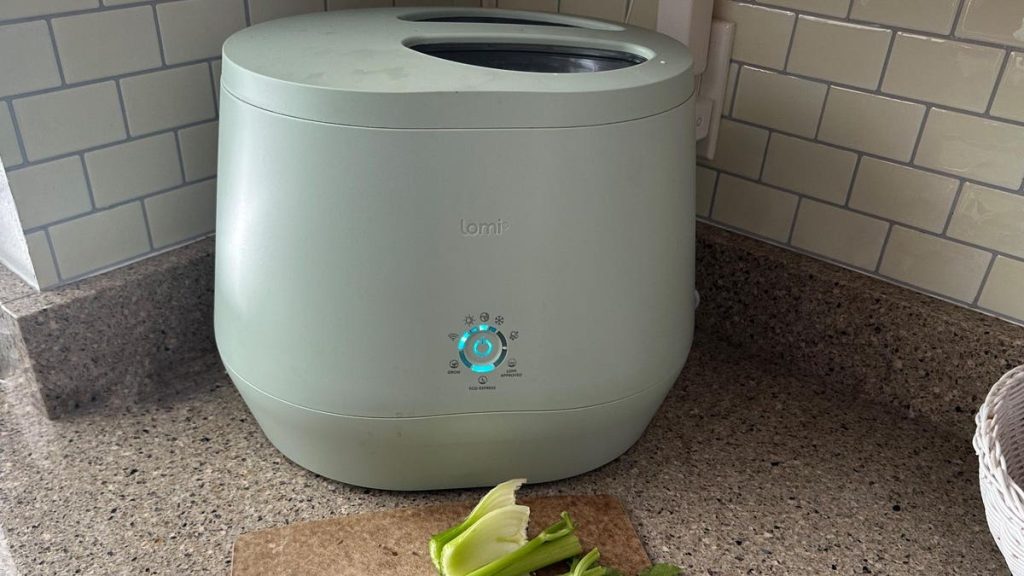Looking to do something more with your food waste than just chucking it in the trash but you also don’t want to deal with the hassle of composting? Good news! Lomi is back with a new device, the Lomi Bloom.
While it may not be the most capacious food composter on the market (that’d be Mill) or even the most convenient (that’d be Vitamix Food Cycler Eco 5 with it’s lidded, removable bin), it’s the most stylish and the one with the best following. How good? Lomi Bloom sold out within minutes of being announced and there’s currently a wait list extending into late October.
So what’s got everyone abuzz about Bloom? I’ve been testing one out for a little over a month to figure out exactly that.
What is it?
Lomi Bloom is a countertop food dehydrator and agitator. Basically, you feed it leftovers and expired foodstuffs from your fridge and instead of stinking up your trash, it turns those scraps into loose “dirt” that you can then add to your compost pile or sprinkle (sparingly) on your lawn or garden.
I say sparingly because, at the end of the day, it’s still dehydrated food stuff. Getting it wet invites things like mold and fungal growth. So while what Lomi Bloom produces is great as a gardening supplement, you couldn’t pot a plant in it. Lomi does have a solution for that…but I’m getting ahead of myself.
The Lomi Bloom looks very much like the original Lomi (now called Lomi Classic). From a functional perspective, the agitator, dehydrator, and internal bucket are exactly the same. The only thing you’ll notice at a glance are the new colors: either black or minty green. Oh, and the skylight lid that was an add-on for the original Lomi now comes standard.
The big changes are on the inside. Lomi Bloom now has a WiFi chip with which it can send status updates to the revamped Lomi app. It can also receive OTA updates (something that Mill has used to great success to tweak performance based on customer feedback).
Is it an improvement over Lomi Classic?
Most definitely yes. Despite being practically the same, functionally, the Lomi Bloom has added new modes to the Bloom and has tweaked the performance to deliver a quicker default cycle (as much as 2 hours faster). There’s also a new deep clean mode to help out when you’ve got gunk blocking up the device.
Lani Bloom is a welcome addition to the countertop. It changes the conversation about what’s “trash” and what could be turned into something useful. At the very least, it keeps your trash can from becoming a toxic bomb. The caveat is that you have to be vigilant about the mix of scraps you put in. Unlike large systems like Mill, where things usually balance out because of the large amount of food waste you’re adding to the bin, fibrous or moisture-heavy components can throw off the mix in Bloom. This results in caked-together bricks of food waste rather than the loosely sifted “earth” that Lomi advertises. But then that’s why there’s the new Deep Clean mode, to help break things up when you jam up your Bloom.
The app connectivity shouldn’t be ignored either. Previously, the Lomi app was nothing more than a digital user manual. Now you can connect your Bloom to the app and…well…not do much at the moment other than earning reward points for every cycle you complete. But there’s the promise of more functionality on the way. Later this fall, you’ll be able to do things like check how long a cycle has left (and maybe set a timer? I hold out hope).
The app lets you see the impact your Lomi Bloom usage has on your environmental impact as well. Though I’ve found its calculations to be somewhat arbitrary, occasionally zeroing out my progress and rewards points (Lomi needs to work on its backend data pipeline).
Speaking of, the rewards system is a tantalizing carrot for frequent usage (which shouldn’t be a problem – Bloom’s capacity is still modest, really only good for about a day of food waste). Lomi is building a customer ecosystem with a rewards system and add-on products to help custom-tailor your Bloom’s output—Lomi Blends.
The new Lomi Blends (purchasable with your Lomi Points) turn your food grounds into legitimate fertilizer. The combination of phosphate, iron, lime, and other essential minerals give your food grounds a bit of structure. Basically your food turns into a delivery mechanism for the stuff your lawn needs. It’s what chemical (and non-chemical) fertilizers do and it’s a really cool concept to be able to make it on your own without a trip to the local garden center.
Where can I buy it?
As I mentioned at the top, Lomi is sold out till late October but you can get a preorder now at $599 or $499 for an “unlimited membership.” The membership is billed quarterly at $60 and also gives you unlimited filter and Pod refills, something that you’ll definitely need.
There are more than a few Reddit threads and grumpy compost-punk influencers online that will angrily harangue you for even mentioning the Lomi Bloom or any powered food cycling device like it—all of their arguments boiling down to “if you really cared about the environment you wouldn’t use energy to do what could be done via a pile of compost in your backyard.” And they aren’t wrong, per se. They are, however, missing the point.
Composting, despite numerous vociferous assertions, is not easy. It requires attention and work and love. Yes, you truly have to love gardening and composting to make it work. And that slams the door to the possibility of composting for a lot of people—those who don’t have room, the time, or the desire.
What people do understand is plugging an appliance into a wall and dumping their scraps in to maybe reduce their footprint just a teeny bit. And it’s that shift in thinking, that development of a community that Lomi is hoping to cultivate. Lomi Bloom may not solve the world’s food waste problems overnight but it will get you started down the path of thinking about food waste differently. Get started with Lomi Bloom on their website.
Read the full article here










